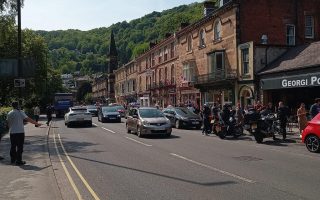If city breaks are something that you enjoy, then you might have Derby on your list. I wouldn’t push it to the top though. On the other hand, if you prefer to base yourself in a city, but spend your time exploring the surrounding area, it’s got plenty within easy reach.
It’s an old town, settled by the Romans, then captured by the Anglo-Saxons and the Vikings in turn. The old market town reached its heyday in the industrial era. Derby claims to be one of the birthplaces of the industrial revolution.

With Derby being at the southern end of the Derwent Valley Mills, that’s not an altogether ridiculous claim. Water power was first introduced to England in the early 1700s by John Lombe at his Silk mill in Derby. The real harnessing of water power was by Richard Arkwright at the nearby Cromford Mills, creating a cotton spinning factory. It provided more employment than the population could provide, so what is believed to be the first factory housing development in the world was created complete with pubs, shops, a school and places of worship. The Derwent Valley Mills are a UNESCO world heritage site.
In the 19th century it became a centre of the British rail industry.
Derby is still a highly industrial area, home to the second largest aero-engine manufacturers in the world, Rolls Royce. Bombardier has a production facility there and Toyota has set up the UK base there.

Wander through the city now and it becomes apparent that it’s a somewhat deprived area, relying largely on the University. It does, however, have some charming points. Surprisingly, Derby is quite a centre for real ale. Ye Old Dolphin Inne is a lovely, traditional pub with a great selection of real ales. The Silk Mill has some nice choices too. There is a statue of Bonnie Prince Charlie in the center of town as he set up camp in Derby on his way South. The city is right on the river, and the weir makes an interesting pattern in the flow.
The star of the show is the cathedral. It’s not the grandest I’ve ever been to, but it has quite a lot of history. The Church of All Saints was founded in 943 by King Edmund of Wessex. The cathedral that you see now is actually a Georgian building, although the tower dates back to the 16th century.

Bess of Hardwick, the most important Tudor woman after Queen Elizabeth, chose the church as her final resting place. The monument that she designed is still on display, although her coffin is in a vault in the now demolished church.
There is a museum in town, however we didn’t stop in.

As mentioned, there are plenty of places to visit within easy reach if you want to spread from the city. Within an hours drive, you can be in the Peak District, walk in the footsteps of the aforementioned Bess of Hardwick at Chatsworth, Hardwick Hall, Old Hardwick Hall or Bolsover Castle. Visit the magnificent Kedleston Hall, Sudbury Hall and enjoy some childhood nostalgia, Calke Abbey, visit Ashby-de-la-Zouch Castle or visit famous prehistoric sites such as Nine Ladies Stone circle, Arbor Low, Minning Low. The Derwent Valley Mills or Cromford Mill have a lot of appeal if the industrial revolution is of interest. Matlock Bath is a curious little place. It is right in the middle of England, but is all done up like a seaside town.

Derby and Derbyshire might not be the first place you’d think of to visit, but with a little planning, you might be surprised by what it can offer.







Spot on with this write-up, I really feel this amazing site needs much more attention. I’ll probably be returning to read more, thanks for the info!